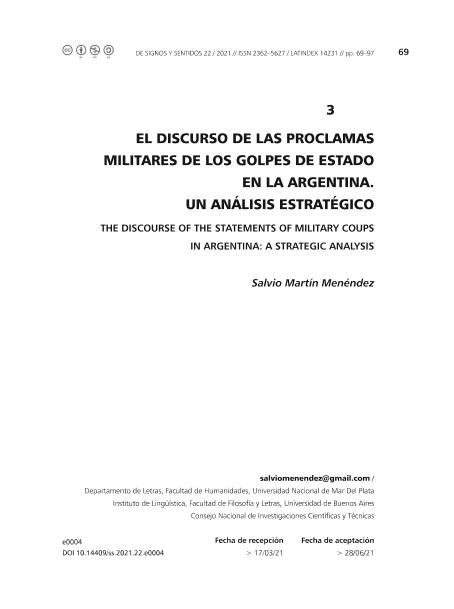Mostrar el registro sencillo del ítem
dc.contributor.author
Menendez, Salvio Martin

dc.date.available
2022-08-23T14:45:29Z
dc.date.issued
2021-10
dc.identifier.citation
Menendez, Salvio Martin; El discurso de las proclamas militares de los golpes de Estado en la Argentina: Un análisis estratégico; Universidad Nacional del Litoral. Secretaría de Planeamiento Institucional y Académico; De Signos y Sentidos; 22; 10-2021; 69-97
dc.identifier.issn
1668-866X
dc.identifier.uri
http://hdl.handle.net/11336/166327
dc.description.abstract
Nos proponemos analizar estratégicamente una serie discursiva compuesta por las proclamas militares de los golpes de estado que tuvieron lugar durante el siglo XX en la República Argentina. La reconstrucción de estos dispositivos estratégicos explica el funcionamiento discursivo y permite justificar la interpretación que se hace de los discursos que forman la serie.La serie está formada por los siguientes discursos: el del 6 de septiembre de 1930 discurso inaugural del golpe de estado, la proclama del 4 de junio de 1943 hecha por el Grupo de Oficiales Unidos (GOU), el del 16 de septiembre de 1955 (Revolución Libertadora), el del 28 de junio de 1966 (Revolución Argentina) y el del 24 de marzo de 1976 (Proceso de Reorganización Nacional).Analizaremos la estrategia Justificar la ruptura del orden constitucional a partir de tres movimientos centrales que la conforman: i) Ubicación del sujeto discursivo; ii) Uso de la paradoja o contradicción explícita y, iii) Invocación.
dc.description.abstract
We propose to strategically analyze a discursive series made of the military proclamations of the coups d’état that occurred during the 20th century in the Argentine Republic. The reconstruction of these strategic devices explains how discourse functions and allows us to justify the discursive interpretation of the series. The series is made up of the following discourses: the inaugural proclamation of September 6, 1930 made by General J. F. Uriburu; the one of June 4, 1943, made by the United Officers Group (GOU); the one of September 16, 1955 (Liberating Revolution), the one of June 28, 1966 (Argentine Revolution), and the one of March 24, 1976 (National Reorganization Process). We will analyze the strategy called Justify the rupture of the constitutional order based on three central movements that make it up: i) Position of the discursive subject; ii) Use of explicit paradox or contradiction and, iii) Invocation
dc.format
application/pdf
dc.language.iso
spa
dc.publisher
Universidad Nacional del Litoral. Secretaría de Planeamiento Institucional y Académico
dc.rights
info:eu-repo/semantics/openAccess
dc.rights.uri
https://creativecommons.org/licenses/by-nc-sa/2.5/ar/
dc.subject
DISCURSO
dc.subject
SERIE
dc.subject
ESTRATEGIA
dc.subject
RECURSO
dc.subject.classification
Lingüística

dc.subject.classification
Lengua y Literatura

dc.subject.classification
HUMANIDADES

dc.title
El discurso de las proclamas militares de los golpes de Estado en la Argentina: Un análisis estratégico
dc.title
The discourse of the statements of military coups in Argentina: A strategic analysis
dc.type
info:eu-repo/semantics/article
dc.type
info:ar-repo/semantics/artículo
dc.type
info:eu-repo/semantics/publishedVersion
dc.date.updated
2022-08-23T11:15:24Z
dc.identifier.eissn
2362-5627
dc.journal.number
22
dc.journal.pagination
69-97
dc.journal.pais
Argentina

dc.journal.ciudad
Santa Fe
dc.description.fil
Fil: Menendez, Salvio Martin. Consejo Nacional de Investigaciones Científicas y Técnicas; Argentina. Universidad Nacional de Mar del Plata. Facultad de Humanidades. Departamento de Letras; Argentina. Universidad de Buenos Aires. Facultad de Filosofía y Letras. Instituto de Lingüística; Argentina
dc.journal.title
De Signos y Sentidos
dc.relation.alternativeid
info:eu-repo/semantics/altIdentifier/url/https://bibliotecavirtual.unl.edu.ar/publicaciones/index.php/DeSignosySentidos/article/view/10807
dc.relation.alternativeid
info:eu-repo/semantics/altIdentifier/doi/http://dx.doi.org/10.14409/ss.2021.22.e0004
Archivos asociados
